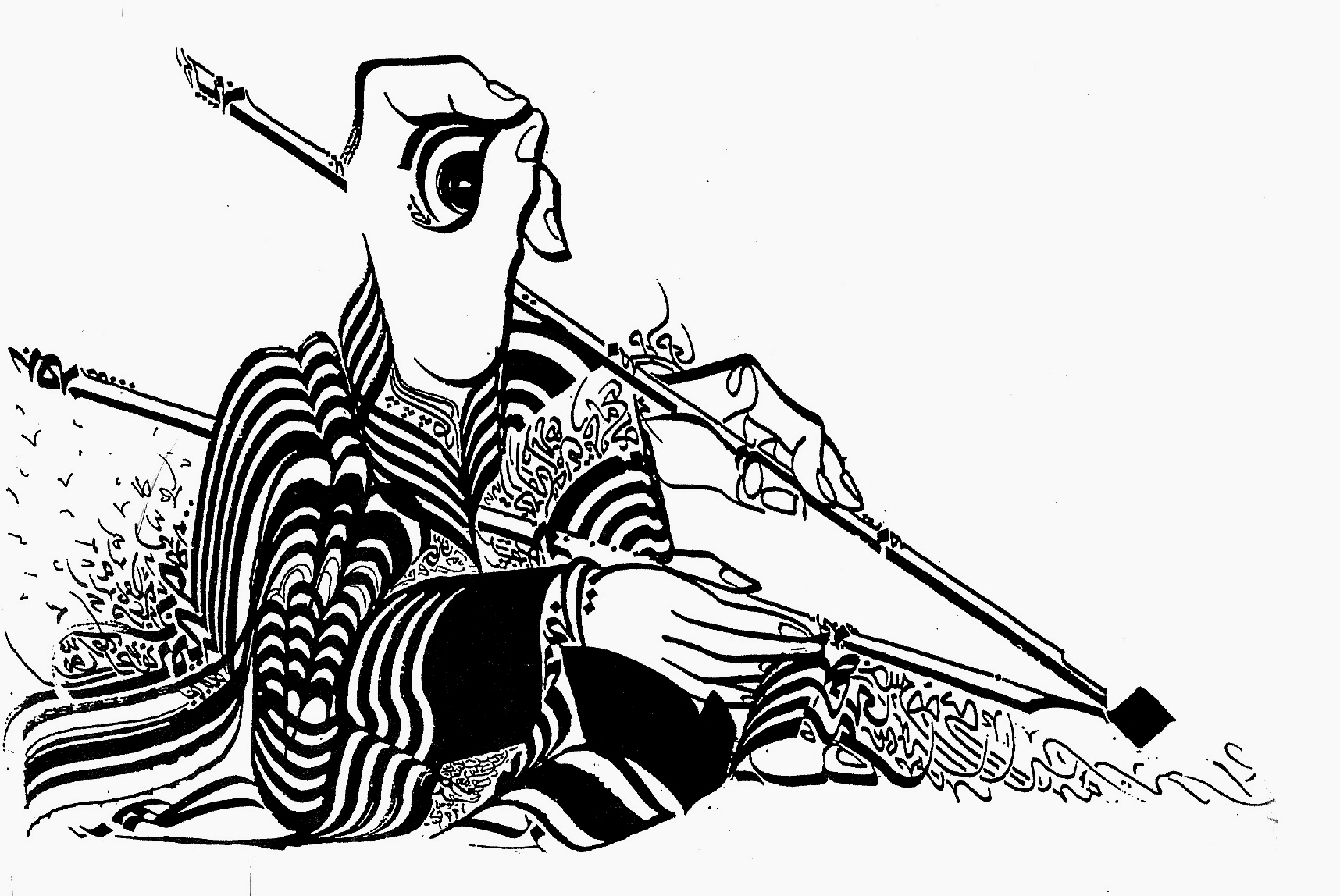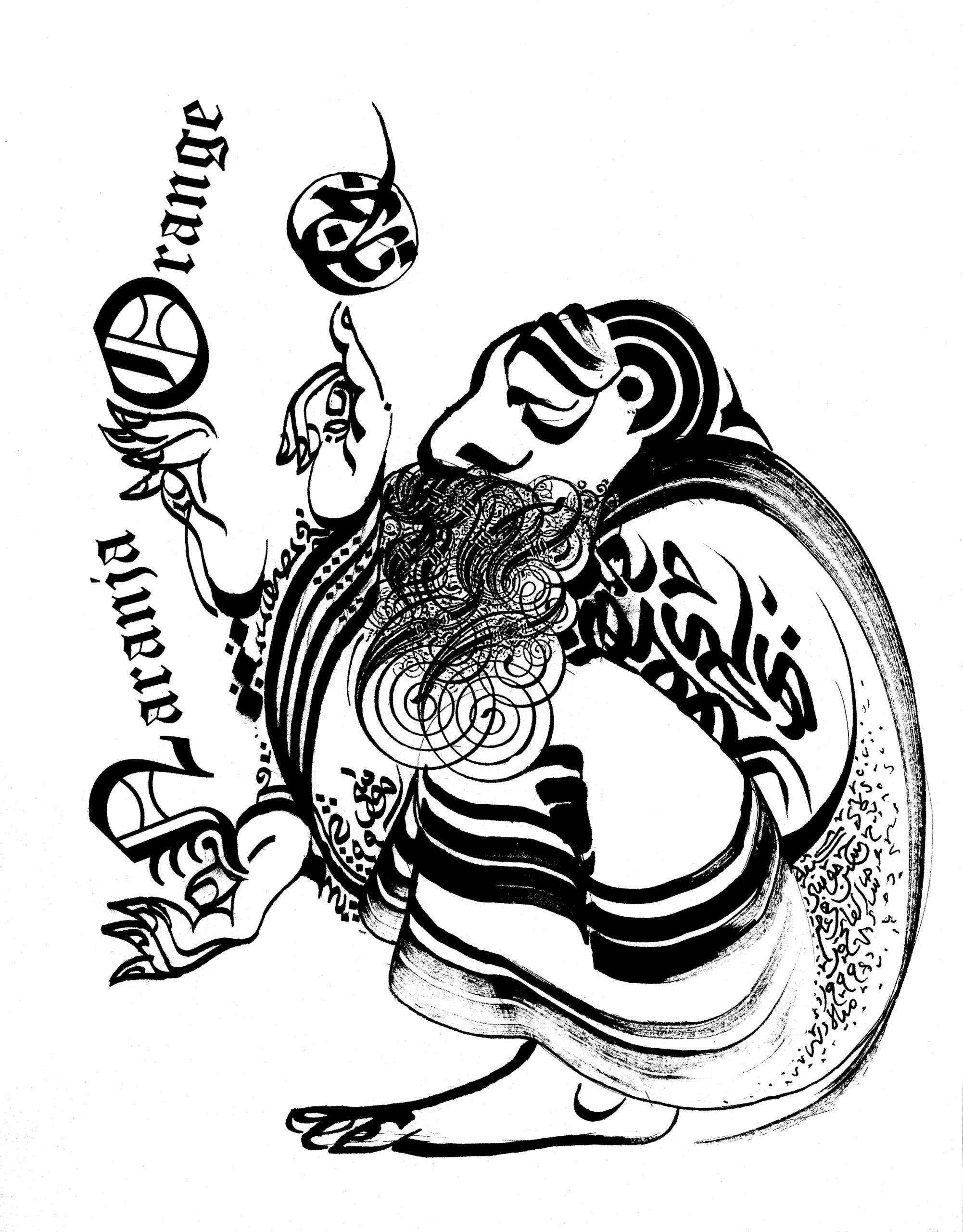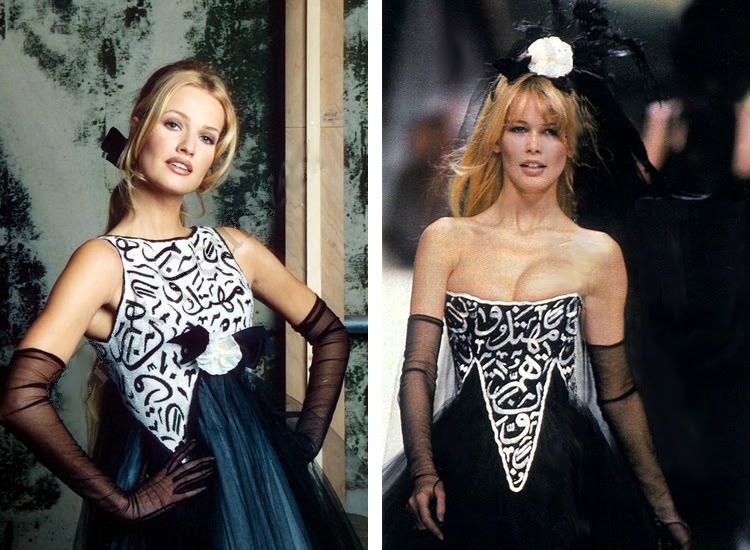WHAT IS CALLIGRAPHY?
The ART OF INK SOCIETY anecdote | MY CALLIGRAPHY [ONLINE SERIES]

The conventional definition of calligraphy limits itself to writings only. That is the reason why I called this online series MY CALLIGRAPHY.
Back in May of 2019, I was contacted by the Art of Ink International Society to participate to an exhibition of contemporary calligraphy. As I happily accepted the invitation and sent 4 images of my calligraphy work, I received an answer from Ronald Nakasone, one of the organizers of this event:
« The Society exhibits the hand written word; illustrations, if any, should be secondary. » . He added : « .. the Society is interested in expressive potential of the brush and the aesthetic of Chinese/Japanese ideograms and/or phonetic symbols ».
Nakasone’s word revealed to me a misunderstanding about the sense of the word calligraphy. The idea of considering my graphic work in terms of « calligraphy » or « illustration » never crossed my mind. I am neither an illustrator, nor a calligrapher and I do not feel comfortable in any of these « political » categories that enables authorities to use the work of creators.
My work is about image making and I made my way through the calligraphers territory because this is where I found the kind of images inexisting elsewhere.
My work may look like calligraphy because I use the tools and the methods of calligraphy but I am interested in the the action of writing as drawing rather than the sense of the « written word » . The act of writing, for me, is far away from making a «written word ».

I think my training as a painter inspired me a non conformist attitude towards the tradition of beautiful writing. Such a liberty was, is, almost forbidden to conventional calligraphers trained to worship the so called tradition. My graphic explorations in Arabic calligraphy was not meant to make a Revolution or what ever! They are supposed to witness my curiosity towards the act of writing which is the most popular form I know of image making.
Handwriting – in general – becomes calligraphy when a writer intends to make calligraphy out of his written marks. Calligraphy is a question of desire. The motivation to make a well-written sign situates a writer in an attitude for research that is aesthetic and open-minded, in which he can create a sign that aesthetically “better”. Such a sign aims to attract, even seduce, the viewer’s gaze.
To make a better sign, a writer must cultivate the material aspects of his practice. Which can be resumed in understanding the potential of his writing tools in relation to his body. Writing is a corporal activity that involves a kind of applied choreography designed to realize a specific graphic order: an image.

I think the links between calligraphy and writing are both simple and complex. Calligraphy, as a graphic practice, can be independent from writing, although its historical evolution is related to the function of beautiful writing. Basically, a calligrapher invents a specific graphic coherence to produce and communicate a visual meaning – an image – while a writer uses an already existing graphic system to produce and communicate a literary meaning – a text. If the writer’s intention is only to produce a readable text, then the writer is not concerned with image making, even if his beautiful marks suggest an image. On the other hand, the calligrapher who may produce a text, while inventing his graphic image, could be indifferent to its literary meaning. I have two examples:
•The great calligrapher Ibn Moqla (886 – 939) wrote the text for a peace convention between Muslim and Byzantine states. The Byzantine courtiers so admired his elegant graphic work that they regularly exhibited Ibn Moqla’s text as a work of fine art to a Byzantine audience who were not literate in Arabic writing. Nevertheless, they appreciated viewing the calligraphic image in the Arabic document.
•In 1994, the French couturier Karl Lagerfeld designed a collection of robes de soirée, evening dresses, for the fashion house Chanel. Some of the gowns were embroidered with Arabic calligraphy. The designer could read the fine visual image in the calligraphy but did not understand Arabic writing which it transpired were verses from the Koran. The American magazine Newsweek (31.01.94) reported that Lagerfeld had to destroy the whole collection with Arabic calligraphy after he was threatened by Muslim fundamentalists from Indonesia. In this particular situation, it is important to note that the Asian Muslims usually read Koranic texts in their own language while the Arabic text appears in a double line, as a visual illustration. I think that both the French designer and his Indonesian Islamists dealt with the Arabic writing as a visual representation of Allah.

If calligraphy could be independent from handwriting, handwriting may suggest calligraphy to the gazer (or le regardeur as Marcel Duchamp would put it) -- although not the writer’s intention. This is where graphology extends the definition of calligraphy to include all types of handwriting as images: writing is an image of the writer’s personality, even if the writer is indifferent to image making. The grapho-logic approach posits all personal handwriting has the possibility to be unique calligraphy. Thus, the official calligraphic writing becomes one possible way, among others, of organizing the writing marks.
Within this perspective all personal writing has calligraphic potential, and may be a conscious, aesthetic ambition. But, all personal writing does not become calligraphy out of a personal desire. Calligraphy also is a question of power, political power. The holders of political power need calligraphy for efficient legibility, to carry out their actions and directives. In this connection between aesthetics and politics, the State selects a type of calligraphy that seems more efficient to bear the political charge of the image they expect others – the people – to receive. With universal education, it is the State that decides the type of calligraphy to be applied in the national educational system. When the State authority disappears in a global world then we can expect graphic legibility propositions from Google , Amazon or Coca cola.
Discover the whole online series MY CALLIGRAPHY on my facebook page: https://www.facebook.com/hassanmusaonline
See more of my calligraphy work in the gallery section: https://hassanmusaofficial.com/calligraphy/
Or take a look at my calligraphy themed picture books in the shop section: https://hassanmusaofficial.com/shop/